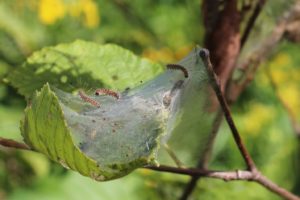By Todd Lanigan, forest health specialist, Eau Claire, Todd.Lanigan@wisconsin.gov, 715-210-0150
Fall webworm started showing up in early July. This native insect feeds on deciduous trees and shrubs and appears every year in yards and forests. It is often noticed first by the loose webbing over branch tips. It can even completely cover a small tree with webbing. If you look inside the webbing, you will find partially eaten leaves, frass (caterpillar poop) and both live and dead caterpillars.

Fall webworm larvae feed within webbed enclosures at branch tips. Credit: Courtney Celley, US Fish & Wildlife Service.
Fall webworm is more of a cosmetic issue than a tree health problem, but the webs can be removed if people are concerned about them. Open the webbing using a rake, fishing pole, long stick or another long tool to allow predators to get at the caterpillars inside. Or people can use their tool to roll up the webbing, peel it away from the branch and place the entire thing in a container of soapy water for a couple of days before discarding.
Insecticides can also be used to control this insect. If you decide to go this route, make sure the insecticide is labeled for caterpillars/fall webworm and that it will penetrate inside the webbing. With all pesticides, the user needs to carefully read and follow label directions.
As a native insect, fall webworm defoliation is unlikely to cause any harm to healthy trees. Use a control method described above if you are concerned about the aesthetics of a defoliated tree. Do not prune off the branch or burn the nest. Burning will cause more harm to the tree than the caterpillars will. For more information about fall webworm, visit this page from Michigan State University Extension.
